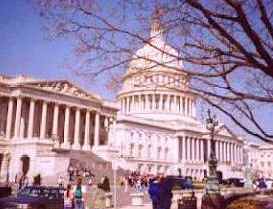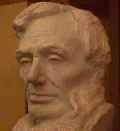Home | News | Books | Speeches | Places | Resources | Education | Timelines | Index | Search
© Abraham Lincoln OnlineAbraham Lincoln
Capitol Hill
and the U.S. Capitol
Washington, D.C.Lincoln's connections to this building are varied and rich, beginning December 6, 1847, when he took his seat in the Thirtieth Congress. During his single term as the lone Whig Party representative from Illinois, he lived across the street at Mrs. Ann Sprigg's boardinghouse. The Library of Congress now stands in this location, just east of the building.
Lincoln as Congressman in the Capitol
The House of Representatives which Congressman Lincoln knew met in a chamber now called Statuary Hall, where he worked with colleagues such as Indiana's Caleb Smith, Georgia's Alexander Stephens, and Pennsylvania's David Wilmot. House Members drew their seats by lot, and on December 8, 1847, Lincoln acquired desk location #191. If you search the floor, you will find bronze markers noting the desk locations of Members like Lincoln who became President.
Soon after his arrival, Lincoln attacked the origins of the war with Mexico. On December 22, 1847, he introduced a series of resolutions called the "Spot Resolutions" which challenged President Polk to locate the place where American blood had been shed on American soil, provoking the war. His position proved unpopular among his constituents, and dogged him for years afterward.
On February 21, 1848, Lincoln was present when 81-year-old Congressman and former President John Quincy Adams collapsed and was named to a committee which organized the funeral arrangements. On February 26 he attended the funeral in the House chamber and marched with the procession to the Congressional Burying Ground.
Alexander Stephens, who later became vice president of the Confederacy, recalled Lincoln as a speaker. "He always attracted the riveted attention of the House when he spoke; his manner of speech as well as thought was original. He had no model. He was a man of strong convictions, and was what Carlyle would have called an earnest man."
While a House Member, Lincoln borrowed books at the Capitol. Elihu Washburne, a political friend, said the librarian of the Supreme Court told this story about Congressman Lincoln: "Mr. Lincoln came to the library one day for the purpose of procuring some law books which he wanted to take to his room for examination. Getting together all the books he wanted, he placed them in a pile on a table. Taking a large bandana handkerchief from his pocket, he tied them up, and putting a stick which he had brought with him through a knot he had made in the handkerchief, adjusting the package of books to his stick he shouldered it, and marched off from the library to his room. In a few days he returned the books in the same way."
Lincoln as President in the Capitol
In 1861 Lincoln returned to the Capitol as President-elect, meeting with both houses of Congress and the Supreme Court justices. On March 4, 1861, he took the oath of office on the building's east side. Standing beneath the unfinished dome, in his First Inaugural Address he pleaded with his countrymen to avoid war.
Civil war followed soon after, and with it came thousands of Union soldiers who temporarily occupied the building, camping in the House and Senate chambers and Rotunda. On April 26, 1861, President Lincoln and other officials attended a dress drill of the 7th New York Regiment in front of the Capitol. Two days later Lincoln and Secretary of State William Seward visited the quarters of this regiment in the House Chamber.
Julia Taft Bayne recalled that the Capitol "had taken on the appearance of an armed fort. About the entrance and between the pillars were barricades of iron plates, intended for the dome, held in place by barrels of sand and cement. All the statuary in the rotunda had been boxed and the pictures covered by rough boards, while the halls within were full of soldiers, drilling."
Julia also remembered when Lincoln's youngest son Tad became lost in the depths of the Capitol basement with her brother Holly (Halsey). In her still-popular book, Tad Lincoln's Father, she wrote, "they got the idea of seeing how far down they could go in the Capitol. They knew the way around the ordinary places but had never been in the sub-basement. 'We went down steps pretty near to China,' Holly explained, 'and when there weren't any more steps to go down, Tad dared me to explore around and we did and got lost.'
"Tad said, 'We knew there couldn't be any bears there, but there were rats and it was awful dark.' It really was a precarious adventure for a couple of boys." A workman finally heard the boys calling and led them out after they had been lost all day.
When Lincoln first took office, the dome we know today was partially completed, braced by ropes of steel. On the lawn below the inaugural crowd could see the model of the statue destined for the top. The finished piece reached the pinnacle on December 2, 1863. Julia noted that when the fastenings were removed, "a white dove, one of a flock which were always around the Capitol grounds, circled around the head of the statue and finally lighted there."
During the war construction costs for the new dome and other parts of the building drew unfavorable remarks. Lincoln, however, stressed the importance of continuing the work, saying, "If people see the Capitol going on, it is a sign we intend the Union shall go on."
As president, Lincoln visited the Capitol periodically to attend lectures, meetings, and religious services. He also spent time in the so-called "Presidents Room," where he signed legislation before Congress adjourned. Here he signed many bills, including ones generated by the Thirty-eighth Congress. On July 4, 1864, however, he balked at the Wade-Davis reconstruction bill. Because the session had ended, his refusal killed the bill, angering Radical Republican Congressmen.
The war was nearly over when Lincoln visited the President's Room on March 3, 1865, to sign more end-of-session legislation. There he received word from Union General Ulysses S. Grant that Confederate General Robert E. Lee had requested a meeting. Through his Secretary of War, Lincoln directed Grant not to confer with Lee, "unless it be for the capitulation of General Lee's army."
The next day, Lincoln returned to the East Portico to deliver his masterpiece Second Inaugural Address with its famous benediction, "With malice toward none; with charity for all; with firmness in the right, as God gives us to see the right, let us strive on to finish the work we are in..."
Lincoln Remembered in the Capitol
The Rotunda has become synonymous with memorials to fallen notables, starting with Senator Henry Clay, whom Lincoln admired all his life. In 1852 Clay was the first to lay in state here after his death. Lincoln, the first American president to be assassinated, followed him in 1865.
After President Lincoln's murder, Benjamin French, commissioner of public buildings, followed the custom of the day by ordering the room's sculpture and paintings covered with black crepe fabric. He also designed the wooden catafalque on which the coffin rested, a much-modified version of which is used in modern-day funerals and is displayed in the Capitol visitor center.
Lincoln's body arrived in the Capitol on the afternoon of April 19, following his White House funeral and a massive procession down Pennsylvania Avenue. Dr. Phineas D. Gurley, the Lincoln family pastor, conducted a brief burial service in the Rotunda for invited guests such as relatives, cabinet members, military officers, and other high-ranking government officials.
The next day the president's open coffin rested in the middle of the room while thousands of public mourners filed by. Journalist Noah Brooks saw the spectacle from atop the huge dome: "Directly beneath me lay the casket in which the dead President lay at full length, far, far below; and like black atoms moving over a sheet of gray paper, the slow-moving mourners, seen from a perpendicular above them, crept silently in two dark lines across the pavement of the rotunda, forming an ellipse around the coffin and joining as they advanced toward the eastern portal and disappeared."
Modern visitors to the Rotunda often notice the marble statue of Lincoln by Vinnie Ream, who sketched Lincoln during the last five months of his life. It was dedicated in 1871 while President Grant and other dignitaries looked on. David Davis, Lincoln's long-time friend from Illinois, had the honor of officially unveiling it.
Near the Senate's west stairway is an immense painting which commemorates a landmark Lincoln event. The First Reading of the Emancipation Proclamation Before the Cabinet by Francis Carpenter depicts July 22, 1862, when Lincoln read the proclamation's initial draft to his Cabinet members. Exactly two years later, Lincoln showed them the completed painting in the White House. The Cabinet members were a contentious group and disliked how they were arranged, but Lincoln pronounced the portraiture "absolutely perfect."
You also can find a bust of Lincoln in the Capitol Crypt sculpted by Gutzon Borglum of Mount Rushmore fame. At one time this huge marble work graced the Rotunda, but now it stands one floor below. A bronze replica stands in front of the Lincoln tomb in Springfield, Illinois, where it has greeted millions of visitors. Visiting Information
If you want to see the building, you will be among thousands of visitors from all over the world. The Capitol is open Monday through Saturday from 8:30 a.m. to 4:30 p.m., except Thanksgiving, Christmas, New Year's Day, and Inauguration Day. The building is free of charge, and entrance to the Visitor Center is on the east side, which faces First Street. To tour the building beyond the Visitor Center, you must make an advance reservation. Click here for more information about tours.
Related Links
Abraham Lincoln's First Inauguration
Abraham Lincoln's Second Inauguration
Death of Representative John Q. Adams (U.S. House of Representatives)
First Reading of the Emancipation Proclamation Painting (US Senate)
Hannibal Hamlin Bust (US Senate)
Hannibal Hamilin Takes Vice Presidential Oath (US Senate)
Jefferson Davis' Farewell to the Senate (US Senate)
Lincoln in Washington Blog/Map
Lincoln Mourned in the U.S. Capitol
Senator Friend of Lincoln's Killed in Battle (US Senate)
Statuary Hall (U.S. House of Representatives)
Union Soldiers Occupy Senate Chamber (US Senate)
U.S. Capitol Virtual Tour (US Senate)Related Reading
Aikman, Lonnelle. We, the People: the Story of the United States Capitol. 1985.
Findley, Paul. A. Lincoln: The Crucible of Congress. New York: Crown Publishers, Inc., 1979.
Riddle, Donald W. Congressman Abraham Lincoln. Urbana: University of Illinois Press, 1957.
Home | News | Education | Timelines | Places | Resources | Books | Speeches | Index | Search Text and photos copyright © 2017 Abraham Lincoln Online. All rights reserved. Privacy Policy


